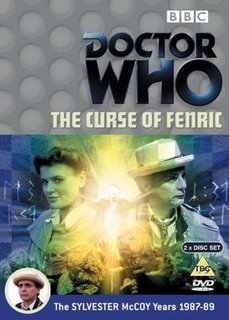 Directed by: Nicholas Mallett
Directed by: Nicholas Mallett
Release date: Original 4 parts aired between 25th October – 15th November 1989
Contains spoilers
The Curse of Fenric was a four part Doctor Who adventure which, on the DVD release, has been given the special edition treatment, with extra footage and cut into film format. Thus on disc 1 you get the series as aired and on disc 2 you get the series cut into a film.
It was with some trepidation that I sat down to watch this. For those who don’t know, Doctor Who was a long running BBC series concerning a timelord, the eponymous Doctor. The Doctor travels through time and space, in the Tardis a vehicle bigger on the inside than the out that is stuck in the form of a police telephone box, battling evil. Timelords, rather than dying, regenerate. A neat trick given that it allows the production company the luxury of changing the lead character’s actor should they depart the series.
I had fallen more and more out of love with the series after Tom Baker left the series, each subsequent Doctor more disappointing to me. The Curse of Fenric was filmed when Sylvester McCoy played the Doctor and it is often felt that poor scripts and stories, and a general attempt to dumb the show down, was deliberately employed by the BBC to kill the series. Thus it really wasn’t the actor’s fault. Fenric is, however, classed as one of the better McCoy era stories and is, of course, about vampires. I tried to put my pre-conceptions to rest as I watched it afresh and, I think, succeeded.
The Doctor and his companion Ace (Sophie Aldred) arrive in England during the Second World War at a top secret naval base where a scientist, Dr Judson (Dinsdale Landen), has developed Ultima, a code cracking computer. In the meantime 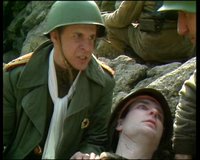 Russian soldiers are coming ashore; even though they are allies their mission is to steal Ultima. As they head towards the shore a mist rises and one of the landing dinghies does not make it and we see the prow of a Viking longboat under the water.
Russian soldiers are coming ashore; even though they are allies their mission is to steal Ultima. As they head towards the shore a mist rises and one of the landing dinghies does not make it and we see the prow of a Viking longboat under the water.
The plot of Fenric is complex, to say the least, and is also quite dark. This is belied by some of the, almost, children TV scripting, but never the less that darkness is there. Essentially, centuries before, the Doctor trapped an intelligent being of pure evil in a bottle. This bottle was, eventually, stolen by Vikings who were attacked for it by a creature called a haemovore. The haemovore is our future, a mutation/evolution of humanity that subsists on blood. From the time when the earth has become nothing but chemical sludge, he was sent back in time by Fenric. He landed in Transylvania in the ninth century and has followed Fenric’s bottle across the globe.
A naturally occurring poison is being gathered by Commander Millington (Alfred Lynch) to use against the Nazis. The British know the Russians are there and are prepared to let them steal Ultima as it is rigged with the poison to be used against them after the war is ended. Millington is, with the help of Judson, also having Viking runes translated in order to search for the treasure of the Vikings (the bottle which holds Fenric). It is all a convoluted game that will allow Fenric to escape and take over a human body. From there he will have the ancient haemovore (from the future) release the poison into the seas in order to destroy the world.
Fenric uses the haemovores. At first these creatures are not seen and we only see their victims, drained of blood with claw marks down their faces.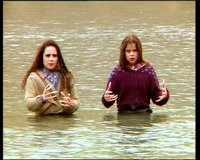 However, as the film progresses two young girls, Phyllis (Joanne Bell) and Jean (Joann Kenny), go swimming in the water and a mist surrounds them. They vanish from view. When they emerge, before a Russian soldier, they have wild hair and long talon like nails. They draw the soldier into the water and he is attacked by other haemovores.
However, as the film progresses two young girls, Phyllis (Joanne Bell) and Jean (Joann Kenny), go swimming in the water and a mist surrounds them. They vanish from view. When they emerge, before a Russian soldier, they have wild hair and long talon like nails. They draw the soldier into the water and he is attacked by other haemovores.
The other ones seem monstrous, but also seem to wear period costumes, as though their life below water has not been kind to them. 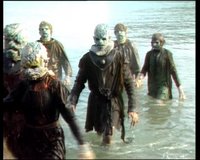 As they run amok we discover interesting things about them. The local Vicar, Wainwright (Nicholas Parsons), tries to hold the girls off with his bible but it is no use as he has no faith. This occurs in daylight. The Doctor orders them away and they obey, though that is not explained. Later the Doctor drives a horde of haemovores away by singing a song of faith. Any faith is sufficient, Ace’s faith in the Doctor or the Russian Captain’s, Sorin (Tomek Bork), faith in the revolution. This is great if only for seeing a vampire driven back, not by a crucifix but by the hammer and sickle. It is explained that faith or belief creates a psychic barrier that is painful to the creatures.
As they run amok we discover interesting things about them. The local Vicar, Wainwright (Nicholas Parsons), tries to hold the girls off with his bible but it is no use as he has no faith. This occurs in daylight. The Doctor orders them away and they obey, though that is not explained. Later the Doctor drives a horde of haemovores away by singing a song of faith. Any faith is sufficient, Ace’s faith in the Doctor or the Russian Captain’s, Sorin (Tomek Bork), faith in the revolution. This is great if only for seeing a vampire driven back, not by a crucifix but by the hammer and sickle. It is explained that faith or belief creates a psychic barrier that is painful to the creatures.
Sorin has heard of something similar to what is happening, which occurred in Romania, where a black mist fell and the dead walked. 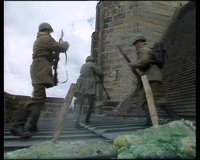 He sharpens stakes and it is good to see that the tried and tested methods work, reducing the haemovores to a pile of green goo. Another power the haemovores have is the manipulation of metal; they can weld with their hands below the sea. This seemed silly but allows them to escape through the metal door of a mine shaft where they have been trapped.
He sharpens stakes and it is good to see that the tried and tested methods work, reducing the haemovores to a pile of green goo. Another power the haemovores have is the manipulation of metal; they can weld with their hands below the sea. This seemed silly but allows them to escape through the metal door of a mine shaft where they have been trapped.
The haemovores overrun the base, converting others into creatures like themselves as Fenric eventually posses a body and orders the presence of the ancient one.
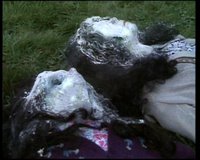 Believing that the end game is afoot he orders the ancient one to disposes of the other haemovores and this is done psychically the others dissolving as his mental command kills them.
Believing that the end game is afoot he orders the ancient one to disposes of the other haemovores and this is done psychically the others dissolving as his mental command kills them.
The story in Fenric is good but is let down by scripting. Despite the fact that the character of Ace is being developed and the writer wanted to show her blossoming womanhood many of her lines are terrible, it is pure kids TV language and feels unnatural. It seems a shame because this story has a really dark heart and better production values than many of the earlier series (they’re not perfect but old Doctor Who was known for its rubber masks and we can live with that). 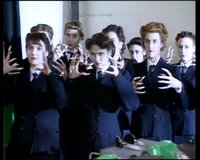 The story seems a little rushed at times as well, with characters suddenly knowing things that perhaps they wouldn’t naturally, but as all the main players have been chosen as pawns in this game by an ancient evil and are descendants of the Vikings then perhaps the writer was implying that there was a deep-seated, inherited knowledge.
The story seems a little rushed at times as well, with characters suddenly knowing things that perhaps they wouldn’t naturally, but as all the main players have been chosen as pawns in this game by an ancient evil and are descendants of the Vikings then perhaps the writer was implying that there was a deep-seated, inherited knowledge.
As I said, I approached this with trepidation and a desire not to succumb to preconceptions. I think I managed that and will give this 6 out of 10.
There is no imdb page for the special edition version of this but there are pages for the four parts, the imdb page for part one is here.
Sunday, August 13, 2006
Doctor Who - The Curse of Fenric (Special Edition) - review
Subscribe to:
Post Comments (Atom)
















No comments:
Post a Comment